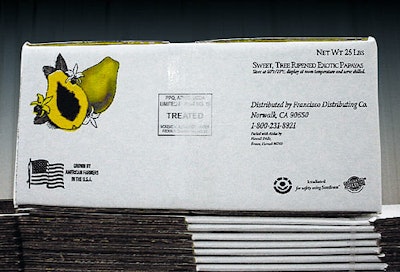
The feds are ready to give a new twist to the packaging of irradiated foods. The Animal and Plant Health Inspection Service (APHIS), a part of the U.S. Department of Agriculture, now wants importers of foreign-grown papayas, litchi, mangos, guavas, and other delicacies to stick an irradiation bar code or indicator—the type has not been specified—on cartons that have been irradiated to kill fruit flies or mango seed weevils. The marking, which would also have to be applied to foreign produce that was irradiated in the United States, would help customs inspectors track those packages.
Initially, this would affect only importers of niche, fresh tropical produce. But the Food and Drug Administration is currently considering a petition from the National Food Processors Assn. (NFPA) asking for approval to irradiate packaged, ready-to-eat meals. Jeffrey Barach, vice president of special projects for the NFPA, notes that his members are anxious to sell ready-to-eat, prepackaged fruit salads and vegetables.
If the FDA grants that petition, which seems likely given the FDA’s recent spate of irradiation approvals (the last being meat in 1999), the Del Montes and Doles of the world will also have to take a crash course in irradiation indicators.
Moreover, the NFPA is pressing APHIS to expand approval of the use of irradiation on fresh fruits and vegetables to any pest or insect, not just fruit flies and mango seed weevils. Brazil, which is trying to fashion itself into the tropical fruit basket of the world, according to one APHIS official, is building numerous irradiation plants for food processing. So are some other countries.
Irradiation indicators will not be required for domestically grown fruit and vegetables, spices, poultry or meat, excepting produce grown in Hawaii. That state is designated a fruit fly pest state by APHIS, and produce shipped from there to the other 49 states has to go through Customs at ports of entry. Irradiation of fruits and vegetables grown elsewhere in the country has been legal since 1986.
Changing perceptions?
Paul DeGrandpre, technical services manager for Pacific Coast Fruit Co., Portland, OR, the largest wholesaler in the Northwest, says irradiated foods face substantial consumer resistance. But he notes that Americans may be much more open to eating foreign-grown foods that have been protected by irradiation in the wake of September 11.
Moreover, some Hawaiian companies such as HawaiiPride, LLC, Keaau, HI, are having success selling irradiated fruits through such upscale retailers as the East Coast’s Harris Teeter, Matthews, NC, which has 142 stores in six eastern states.
But both DeGrandpre and John Clark, president of HawaiiPride, emphasize that produce wholesaling is a very low-margin business. Clark maintains that a “dosimetry” indicator requirement (that demonstrates irradiation level) is both unnecessary, given his quality control steps, and untested.
Clark packages every shipment of his Hawaiian-grown fruit—and he has a number of different box sizes as marketing tools—in what the corrugated box industry calls a “pest-free” carton, then tapes over the carton, irradiates the fruit in the carton, stacks the cartons on a pallet, and then wraps the pallet in mesh netting whose holes are so small that pests cannot get through. Companies such as Weyerhaeuser Corp. (Seattle, WA) say they make “pest-free” cartons. Each carton HawaiiPride ships is labeled “treated with or by irradiation” and the well-known irradiation radura symbol is printed on the box. Individual papayas are also labeled.
Electronic radiation
HawaiiPride uses an electronic irradiation process called SureBeam™, that is a registered trademark of SureBeam Corp. (San Diego, CA). SureBeam says its technology decimates pest infestations in mango, guava, kiwi, litchi, tomato, asparagus, cabbage, cauliflower, and papaya. SureBeam also extends the shelf life of those products, the produce company says. HawaiiPride built its own SureBeam facility on Keaau and irradiates fruit and vegetables for other Hawaiian companies, too.
SureBeam has a facility under construction in Brazil, another at the ground-breaking stage in Los Angeles, and a third on the drawing board for New York. Two SureBeam facilities already operate in Sioux City, IA, and Chicago. Other companies have built and are building irradiation facilities in the U.S., including Isomedix, Inc., a unit of Steris Corp. (Mentor, OH).
Whether sold unpackaged or prepackaged, irradiated imported produce has a big advantage over fruits and vegetables treated conventionally with methyl bromide and hot or cold pasteurization. The irradiated fruit and vegetables can be picked much closer to ripeness, they are not dehydrated by four hours at 140°F, and their shelf life is longer.
The ‘indicators’
APHIS wants importers to attach irradiation “indicators” to each container of foreign fruits and vegetables, whether they have been irradiated here or in the country in which they were grown. These indicators would change color or undergo some other visual change once they were irradiated within a certain dose range.
APHIS would set the dose range depending on the pest. APHIS says there are “several inexpensive devices and dye-impregnated labels that react to radiation at various doses in the ‘100-250 gray range.’”
APHIS has said that a phosphor-based technology exists that allows an inexpensive hand-held “light pen” reader to detect an invisible fluorescence from irradiation of a dosimetry label. Indicators could also be incorporated into a white-on-white bar code whose background would darken after irradiation. The agency claims an unnamed manufacturer contends it could produce indicators in large quantities for pennies per indicator.
These package indicators would be a secondary enforcement tool and, perhaps more important, make life a little easier for customs inspectors at U.S. ports who are trying to correlate documents with cartons. Dosimeters would be used as the front-line enforcement tool to indicate that cartons claiming products that have been irradiated had, in fact, been irradiated to the correct dosage.
Clark of HawaiiPride doesn’t think irradiation indicators on cartons will add any assurance above and beyond what he already provides on his cartons; and the extra cost of putting the indicators on the cartons will be prohibitive. “With rapid changes in technology, it is not out of the question that the type of dosimetry system on the boxes some people are suggesting might be feasible in the future at a relatively inexpensive cost,” he states. “However,” he continues, “we feel that adding the burden of this cost with no additional benefit is very poor policy.”
Arnold Foudin, assistant director of scientific services at APHIS, acknowledges that the accuracy of the indicator tags isn’t as ironclad as the agency would like. But he says they don’t have to be 100% accurate; they aren’t being used to assure the safety of the food, only that pests have been sterilized.
On the issue of cost, Foudin explains that APHIS has received phone calls from dosimetry indicator suppliers but has not gotten into details with them. Nor will the agency until perhaps after the petition is finally granted. Foudin adds, “If these vendors are smart, they will realize that they are looking at a potential market that is bigger than anything they have ever seen. If they were smart, they would give the indicators away at the start.”

























